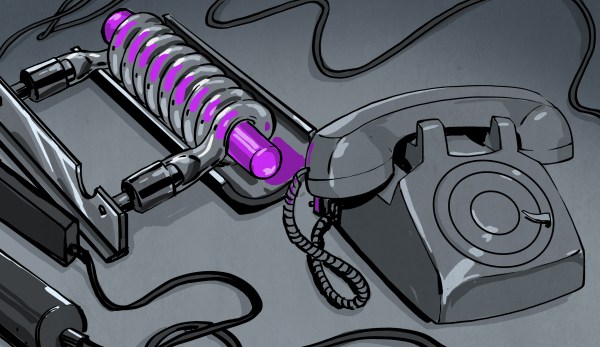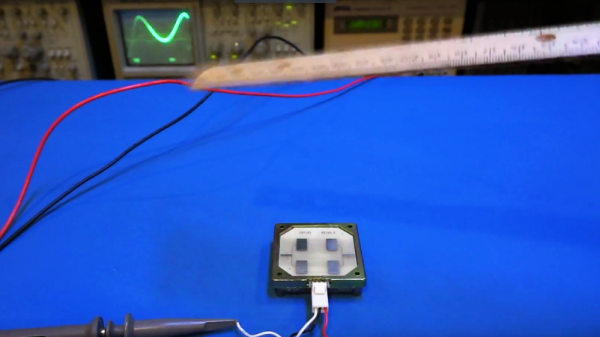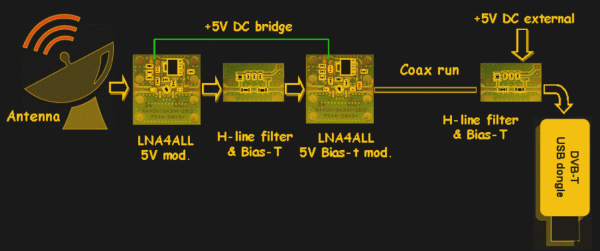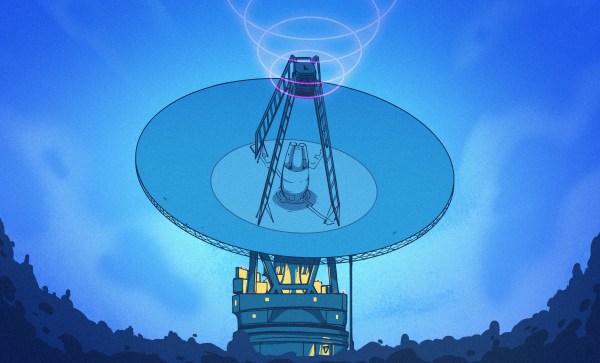Lasers are such a fundamental piece of technology today that we hardly notice them. So cheap that they can be given away as toys and so versatile that they make everything from DVD players to corneal surgery a reality, lasers are one of the building blocks of the modern world. Yet lasers were once the exclusive province of physicists, laboring over expansive and expensive experimental setups that seemed more the stuff of science fiction than workhouse tool of communications and so many other fields. The laser has been wildly successful, and the story of its development is an intriguing tale of observation, perseverance, and the importance of keeping good notes.
microwave101 Articles
Are Microwave Guns For Real?
Almost exactly one year ago, [Kreosan] published a video detailing an EM “weapon” built out of three magnetrons, some batteries, and a taser. It all seemed a bit too good to be true, so [Allen] decided to try and replicate the results for himself.
[Kreosan]’s original video was impressive, showing everything from home stereos to a humble moped exploding when in the presence of their powerful device. However, many of those watching the video doubted the footage. Most criticism centered around the nature of the power supply to the magnetron falling short of the usual 700-1000W seen in a microwave oven.
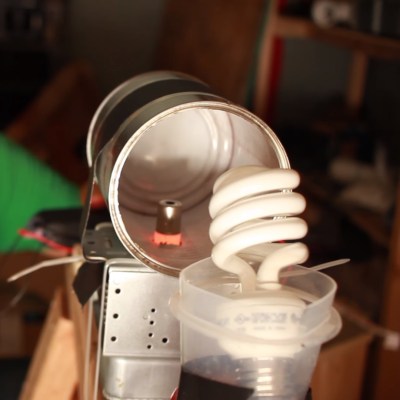
[Allen] starts by experimenting with a single magnetron, successfully using it to light a compact fluorescent bulb at a range of a few centimeters. Scaling up to the full triple magnetron setup with a cardboard and foil feedhorn, [Allen] is, at best, able to crash a calculator at a distance of a few feet.
The microwaves cause no explosions, and the device doesn’t seem to have anywhere near the 50-foot range claimed by [Kreosan] for their device. [Allen] puts forth the theory that the explosions seen in the original footage are far more likely to be from small firecrackers rather than any electronic components dying from microwaves.
Overall it’s a solid attempt to recreate someone else’s work to verify the results, a cornerstone of science. We did bristle somewhat at the valiant 18650 being described as a “vape battery”, however. For more microwave goodness, check out this attempt to recreate the TSA’s body scanners.
Cuban Embassy Attacks And The Microwave Auditory Effect
If you’ve been paying attention to the news, you may have seen a series of articles coming out about US staffers in Cuba. It seems that 21 staffers have suffered a bizarre array of injuries ranging from hearing loss to dizziness to concussion-like traumatic brain injuries. Some staffers have reported hearing incapacitating sounds in the embassy and in their hotel rooms. The reports range from clicking to grinding, humming, or even blaring sounds. One staffer described being awoken to a horrifically loud sound, only to have it disappear as soon as he moved away from his bed. When he got back into bed, the mysterious sound came back.
Cuba has denied any wrongdoing. However, the US has already started to take action – expelling two Cuban diplomats from the US in May. The question though is what exactly could have caused these injuries. The press has gone wild with theories of sonic weaponry, hidden bugs, and electronic devices, poisons, you name it. Even Julian Assange has weighed in, stating “The diversity of symptoms suggests that this is a pathogen combined with paranoia in an isolated diplomatic corps.”
So what’s going on? Bizarre accidents? Cloak and dagger gone awry? Mass hysteria among the US state department, or something else entirely? Continue reading “Cuban Embassy Attacks And The Microwave Auditory Effect”
Doppler Module Teardown Reveals The Weird World Of Microwave Electronics
Oscillators with components that aren’t electrically connected to anything? PCB traces that function as passive components based solely on their shape? Slots and holes in the board with specific functions? Welcome to the weird and wonderful world of microwave electronics, brought to you through this teardown and analysis of a Doppler microwave transceiver module.
We’ve always been fascinated by the way conventional electronic rules break down as frequency increases. The Doppler module that [Kerry Wong] chose to pop open, a Microsemi X-band transceiver that goes for about $10 on eBay right now, has vanishingly few components inside. One transistor for the local oscillator, one for the mixer, and about three other passives are the whole BOM. That the LO is tuned by a barium titanate slug that acts as a dielectric resonator is just fascinating, as is the fact that PB traces can form a complete filter network just by virtue of their size and shape. Antennas that are coupled to the transceiver through an air gap via slots in the board are a neat trick too.
[Kerry] analyzes all this in the video below and shows how the module can be used as a sensor. If you need a little more detail on putting these modules to work, we’ve got some basic circuits you can check out.
Continue reading “Doppler Module Teardown Reveals The Weird World Of Microwave Electronics”
Cascade LNAs And Filters For Radioastronomy With An SDR
It may not be the radio station with all the hits and the best afternoon drive show, but 1420.4058 MHz is the most popular frequency in the universe. That’s the electromagnetic spectral line of hydrogen, and it’s the always on the air. But studying the H-line is a non-trivial task unless you know how to cascade low-noise amplifiers and filters to use an SDR for radio astronomy.
Because the universe is mostly made of hydrogen, H-line emissions are abundant, and their distribution can tell us a lot about the structure of galaxies. The 21-cm emission line is so characteristic and so prevalent that we used it as a unit of measurement on the plaques aboard the Pioneer probes as well as in the instructions for playing back the Voyager recordings. But listening in on 21-cm here on Earth requires a special setup, which [Adam (9A4QV)] describes in a detailed paper on the subject (PDF). [Adam] analyzes multiple configurations of LNAs and filters, both of which he sells, to determine the optimum front-end for 21-cm work. His analysis is a good primer on LNAs and explains why the front-end gear needs to be as close to the antenna as possible. Using his LNAs and filters and an SDR dongle, a reasonable 21-cm rig can be had for about $200 or so, less the antenna. He promises a follow-up paper on homebrew 21-cm antennas; we’ll be looking forward to that.
Not keen on the music of the spheres and prefer to listen to our own spacecraft instead? Then read up on the Deep Space Network and how you can snoop in.
Serious DX: The Deep Space Network
Humanity has been a spacefaring species for barely sixty years now. In that brief time, we’ve fairly mastered the business of putting objects into orbit around the Earth, and done so with such gusto that a cloud of both useful and useless objects now surrounds us. Communicating with satellites in Earth orbit is almost trivial; your phone is probably listening to at least half a dozen geosynchronous GPS birds right now, and any ham radio operator can chat with the astronauts aboard the ISS with nothing more that a $30 handy-talkie and a homemade antenna.
But once our spacecraft get much beyond geosynchronous orbit, communications get a little dicier. The inverse square law and the limited power budget available to most interplanetary craft exact a toll on how much RF energy can be sent back home. And yet the science of these missions demands a reliable connection with enough bandwidth to both control the spacecraft and to retrieve its precious cargo of data. That requires a powerful radio network with some mighty big ears, but as we’ll see, NASA isn’t the only one listening to what’s happening out in deep space. Continue reading “Serious DX: The Deep Space Network”
Horns Across America: The AT&T Long Lines Network
A bewildering amount of engineering was thrown at the various challenges presented to the United States by the end of World War II and the beginning of the Cold War. From the Interstate Highway System to the population shift from cities to suburbs, infrastructure of all types was being constructed at a rapid pace, fueled by reasonable assessments of extant and future threats seasoned with a dash of paranoia, and funded by bulging federal coffers due to post-war prosperity and booming populations. No project seemed too big, and each pushed the bleeding edge of technology at the time.
Some of these critical infrastructure projects have gone the way of the dodo, supplanted by newer technologies that rendered them obsolete. Relics of these projects still dot the American landscape today, and are easy to find if you know where to look. One that always fascinated me was the network of microwave radio relay stations that once stitched the country together. From mountaintop to mountaintop, they stand silent and largely unattended, but they once buzzed with the business of a nation. Here’s how they came to be, and how they eventually made themselves relics.
Continue reading “Horns Across America: The AT&T Long Lines Network”

